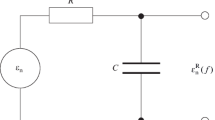Abstract
An absolute calibration by means of the reciprocity theorem has been applied to the calibration of contact-type phonocardiographic microphones. The methods are discussed in detail and examples of the results are presented. Human chest wall vibrations have been measured with these calibrated microphones and the results are also presented.
Sommaire
Un calibrage absolu utilisant le théorême de réciprocité a été appliqué au calibrage de microphones phonocardiographiques du type à contact. Les méthodes sont discutées en détail et des examples des résultats sont présentés. Les vibrations de la paroi thoracique humaine ont été mesurées avec ces microphones calibrés et les résultats sont également présentés.
Zusammenfassung
Es wurde eine absolute Kalibrierung für die Kalibrierung von phonokardiographischen Mikrophonen des Berührungstyps mittels des Reziprozitättheorems vorgenommen. Die Verfahren werden in Einzelheiten besprochen und es werden Beispiele der Ergebnisse gebracht. Es sind menschliche Brustwandschwingungen mit diesen kalibrierten Mikrophonen gemessen worden und die Ergebnisse werden auch gebracht.
Similar content being viewed by others
Abbreviations
- Z c :
-
mechanical impedance of human chest wall
- E :
-
voltage appearing at the electrical terminals of the phonocardiographic microphone
- I :
-
current entering the electrical terminals of the microphone
- F :
-
force applied to the mechanical terminals of the microphone
- V :
-
velocity appearing at the mechanical terminals of the microphone
- S :
-
velocity response of the phonocardiographic microphone (moving coil type), i.e. the ratio of the induced e.m.f. (V) of the unit to velocity (ms−1) at its mechanical terminals
- E′, I′, F′ andV′ :
-
primes indicate the values from the first experiment of the calibration (double or triple prime is also defined according to this definition)
- S 1,G 1,...:
-
suffix 1 indicates the values from microphone 1 (suffix 2 or 3 is similar)
- Z 12=F′/V′ :
-
mechanical transfer impedance from the first experiment
- m 0 :
-
mass of the coupler
- m, s andr :
-
mass, stiffness and mechanical resistance of the microphone
- S m andR m :
-
stiffness and mechanical resistance of the Moltopren (soft rubber) sheet used in the calibration
- U :
-
displacement response of the phonocardiographic microphone (electrostatic type), i.e. the ratio of the induced e.m.f. (V) of the unit to the displacement (m) at its mechanical terminals
- ω:
-
angular frequency
- L :
-
reading of the variable resistance attenuator
- F c andV c :
-
mechano-motive force and free velocity of the chest wall due to the heart action
- Z m :
-
mechanical input impedance of the phonocardiographic microphone
- K * andK ** :
-
reciprocity constants
- Z T :
-
mechanical transfer impedance of the coupler
- Z I :
-
mechanical impedance of the coupler which is fixed at another side
- J :
-
force response of the phonocardiographic microphone (piezoelectric type), i.e. the ratio of the induced e.m.f. (V) of the unit to force (Newtons) applied to its mechanical terminals
References
Bárány, E. (1942) On the mechanical impedance of the human thorax.Acta med. scand. CXI, 252–260.
Cook, R. K. (1940) Absolute pressure calibrations of microphones.J. Res. N. B. S. 25, 489–505.
Foldy, L. L. andPrimakoff, H. (1945) A general theory of passive linear electroacoustic transducers and the electroacoustic reciprocity theorem. I.J. acoust. Soc. Am. 17, 109–120.
Franke, E. K. (1951) Mechanical impedance measurements of the human body surface.USAF Tech. Rep. No. 6469, 1–25.
Harrison, M., Sykes, A. O. andMarcotte, P. G. (1952) The reciprocity calibration of piezoelectric accelerometers.J. acoust. Soc. Am. 24, 384–389.
Ikegaya, K., Suzumura, N. andMatsuhisa, K. (1967) On the measurement of the mechanical impedance of human chest wall with a vibrometer (an impedance measuring head) of dynamically driven and electrostatically measuring type (in Japanese).Jap. J. Med. Electron. biol. Engng,5, 345–351.
Ikegaya, K., Suzumura, N. andFunada, T. (1968) The calibration of the contact type phonocardiographic microphone (in Japanese).Jap. J. Med. Electron. biol. Engng 6, 399–401.
Ikegaya, K., Suzumura, N. andFunada, T. (1968) Reciprocity calibration of the contact type phonocardiographic microphone (in Japanese).Proc. 7th Jap. Conf. Med. Electron. biol. Engng 140.
Ikegaya, K., Suzumura, N. andFunada, T. (1968) Phonocardiographic microphone used a fixed beam as stiffness (in Japanese).Proc. 7th Jap. Conf. Med. Electron biol. Engng 139.
Ikegaya, K., Suzumura, N. andFunada, T. (1969) The contact type phonocardiographic microphone measuring both velocity and displacement (in Japanese).Jap. J. Med. Electron biol. Engng.7, 89–91.
Levy, S. andBouche, R. R. (1956) Calibration of vibration pickups by the reciprocity method.J. Res. N. B. S. 57, 227–243.
Oono, T. (1967) The influence of load on the mechanical impedance of the chest wall (in Japanese).J. acoust. Soc. Japan.23, 12–19.
Primakoff, H. andFoldy, L. L. (1947) A general theory of passive linear electroacoustic transducers and the electroacoustic reciprocity theorem.II.J. acoust. Soc. Am. 19, 50–58.
Rotterdam, A. van andVollenhoven, E. van (1967) Problems in relation to measurement of chest wall movement due to heart action.Med. biol. Engng.5, 339–346.
Takagi, S., Yoshimura, S. andOkamura, T. (1964) Trial and success in the technical realization of requirements for phonocardiographic microphones.Med. biol. Engng.2, 123–134.
Thompson, S. P. (1948) Reciprocity calibration of primary vibration standards.J. acoust. Soc. Am. 20, 637–640.
Trent, H. M. (1948) The absolute calibration of electromechanical pickups.J. appl. Mech. 15, 49–52.
Vollenhoven, E. van (1968) Progress report of Inst. Med. Phys. TNO. No.PR1, 13–19.
Vollenhoven, E. van, Wallenberg, J., Rotterdam, A. van andStraaten, J. van (1968) Calibration of contact microphones for phonocardiography.Med. biol. Engng 6, 71–82.
Author information
Authors and Affiliations
Rights and permissions
About this article
Cite this article
Ikegaya, K., Suzumura, N. & Funada, T. Absolute calibration of phonocardiographic microphones and measurements of chest wall vibration. Med. & biol. Engng. 9, 683–692 (1971). https://doi.org/10.1007/BF02474649
Issue Date:
DOI: https://doi.org/10.1007/BF02474649




